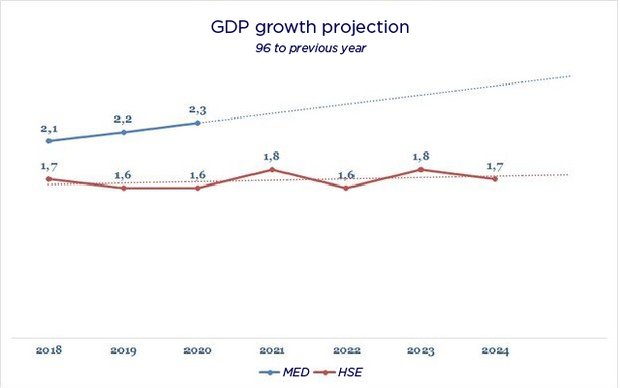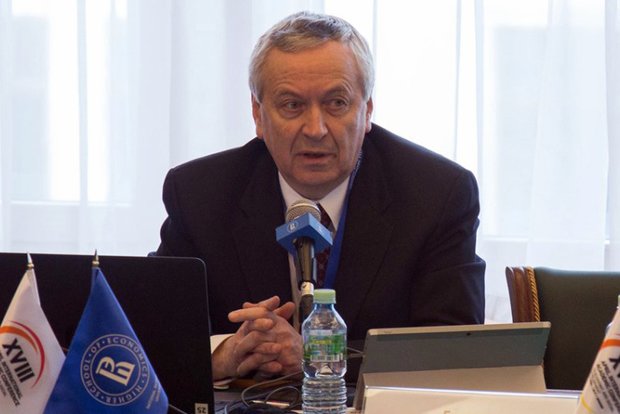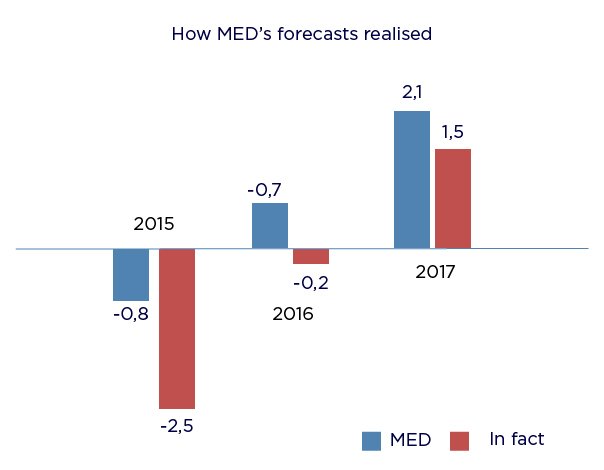'A premonition of recession': why nobody believes Oreshkin’s economic forecast
Experts predict seven years of low growth in Russia. Some expect a downturn
More than two dozen Russian and foreign experts interviewed by the Higher School of Economics (HSE) did not believe the forecast of the Ministry of Economic Development (MED) about Russia's GDP growth by 2% and more in the coming years. Experts believe that such growth is impossible on the horizon of seven years, and some of them even predict a recession. Why nobody believes the forecast of the ministry – read in the material of Realnoe Vremya.
'Disturbing overtones'
On February 14-22, the HSE Centre of Development Institute interviewed professional forecasters of major Russian and foreign organisations about medium- and long-term prospects of the Russian economy. The survey involved 26 experts from Alfa-Bank, VTB Capital, Sberbank, Promsvyazbank, KAMAZ, The Boston Consulting Group, BCS, JPMorgan, Morgan Stanley, as well as other companies and think tanks.
Experts were asked to make a number of forecasts concerning GDP growth, inflation, the dollar against the ruble, oil prices and the key rate of the Central Bank for the period 2018-2024.
The results have turned out to be bleak. Experts' expectations are significantly worse than the official baseline scenario of the Ministry of Economic Development of Russia. According to the consensus forecast of the HSE, an economic growth of 2% and higher, which officials anticipate, is not expected not only in 2018-2020, but also on the horizon of seven years.
Moreover, some of the experts predict a recession in certain years. For example, one expects the economy to decline by 2% in 2022 (in his opinion, a recession will also affect 2023); another respondent believes that a decline in real GDP by 0,8% will occur in 2020.

According to the baseline scenario of the Ministry of Economic Development, the Russian economy should grow by 2,1% this year and by 2,2-2,3% in the next two years. The generalized forecast of economists describes the following scenario: at the end of 2018, the growth rate of GDP will accelerate slightly — by 0,2 percentage points to 1,7%. The peak of growth will be in 2021 and 2023 — but in these years the economy will grow only by 1,8%.
On the basis of the surveys' results, the HSE concludes: experts ''have a premonition of recession, which have added additional disturbing overtones [in the forecasts]''. ''This means that Russia's position in the global economic 'table of ranks' will continue to deteriorate for quite some time. Even absolute optimists do not expect the rate more than 2,5% a year,'' says the HSE.
Time will tell
There has been no economic growth of 2% and more in Russia since 2012. The growth rate has slowed sharply in 2013 — to 1,8% against 3,7% a year earlier. In 2015-2016, there was a decline (by 2,5% and 0,2% respectively), and last year GDP grew by 1,5%.
''GDP growth rates reflect not only objective external and internal conditions, but also the policy of the government and the Central Bank, as well as real law enforcement practice. I think that the predictions of experts are based on the trends in the part of reforms and law enforcement practices that have been observed in recent years,'' says Yevsey Gurvich, the head of Economic Expert Group (he was one of the HSE respondents).
As for the government, it seems its assessments are based on the assumption that ''a new programme outlined in the president's address will be successfully implemented'', Gurvich argues: ''Time will tell whose assumptions are more realistic.''

''Rather restrained expectations concerning growth of the Russian economy among forecasters are connected with that the current economic situation doesn't promote growth in personal incomes. Growth of energy and other raw materials production is a rather weak way to increase the country's GDP,'' believes Andrey Kochetkov, an analyst at Otkritie Broker.
The data on foreign trade indicate a small increase in the supply of non-primary products, but this, according to Kochetkov, is still insignificant figures: ''The more significant is that over the past year, the incomes of the population have not changed much. Without improved welfare of the population, any GDP growth — above 2% or above the world average — is almost impossible. To reverse the trend, it clearly requires lower Central Bank's rates, but they will be useless if the population does not have the prospect of income increases. In a situation when incomes are falling, the population is expanding the demand for micro-loans to cover urgent needs rather than planning long-term purchases.''
''We can easily reach 2,5-3%. Good external environment, plus lower rates, plus certain increase in government spending. The question is how to achieve a steady multi-year growth of 3,5-4%. This is the main task. Indeed, there are no grounds for such expectations so far, and all long-term forecasts are around 1,5-2%,'' says Kirill Tremasov, the head of the analytical department at Loko-Invest and former director of the department of macroeconomic forecasting at the Ministry of Economic Development of Russia.
There is confidence in oil
The forecasts made by the Ministry of Economic Development and its head Maksim Oreshkin (and former head Alexey Ulyukayev) have come true very rarely. For example, last April, Minister Oreshkin stated that at the end of 2017 the incomes of Russians would grow by 1%. It turned out differently — a decrease in real disposable incomes by 1,7%. In 2016, the country's economy, according to the ministry, was to grow by 0,7%. In reality, GDP declined.

Meanwhile, the expectations of HSE respondents turned out to be close to the expectations of the Ministry of Economic Development in terms of inflation. According to the consensus forecast, inflation this year and next year will be 3,8% and 3,9% respectively, and in 2020 it will reach the Central Bank's target of 4%. The ministry predicts inflation in 2018-2020 at the level of 4%
But experts disagree with officials in the estimates of oil prices significantly — according to economists, the prices will be higher than provided in the baseline scenario of the Ministry of Economic Development. The ministry predicts that in 2018 the Urals will cost $43,8 a barrel, in the next two years — even less, while the consensus forecast suggests that the price will remain at the level of $59-60 until 2024.